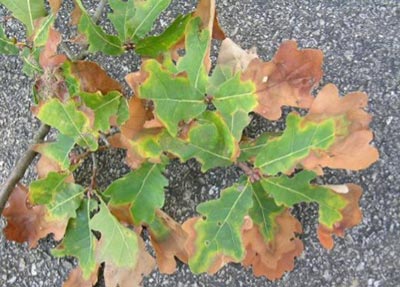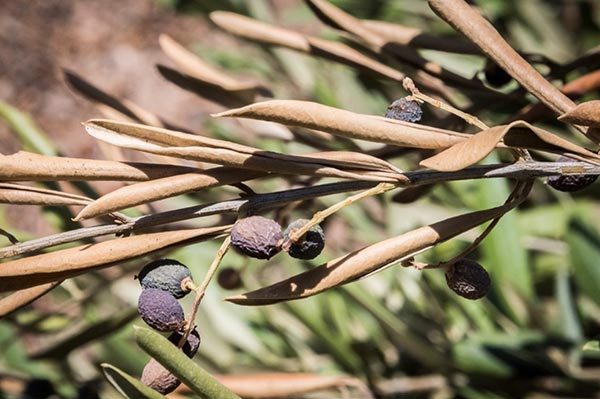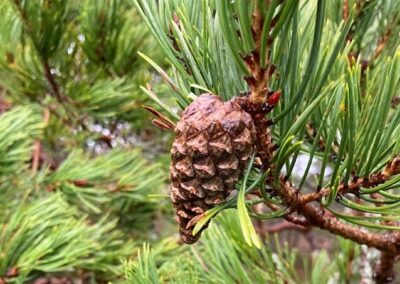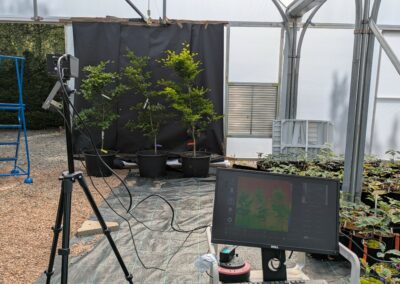Assessing the potential impact of Xylella bacteria on UK trees
Project leads Jiaqi Wei I PhD Student, University of Birmingham; Dr Lisa Ward | Forest Research; Prof Robert Jackson | University of Birmingham
Lead organisations Forest Research; University of Birmingham School of Biosciences
Collaborators N/A
Project status Active (April 2021 – March 2025)
Project funding £106,500
Research outcomes Response | Resistance I Recovery
Context
Xylella fastidiosa is a pathogen of global importance. The bacterium causes disease in a wide range of plant species. At least four subspecies of X. fastidiosa have been reported, each having a different host range. Native to the America’s, it has recently spread into Europe where it has caused the death of thousands of olive trees in Southern Italy. The pathogen has since been reported in Portugal, Spain, and Southern France (including Corsica). X. fastidiosa has not yet been detected in the UK, but there is considerable concern around the potential threat to the UK’s horticulture and environment including the UK’s woodlands and forests, should it establish.
Understanding the threat that the pathogen poses to UK trees is critical in an outbreak situation. Knowing which tree species are likely to be susceptible will help to inform the likely extent of spread in UK woodlands and forests and will ensure susceptible sites can be surveyed and monitored effectively. As well as understanding the susceptibility of UK trees to X. fastidiosa, having a knowledge of potentially resistant tree species may also help us understand how resilient the UK’s woodlands and forests might be in a short-term outbreak or a longer-term establishment of the bacterium.
In this PhD project, several native or naturalised tree species including Prunus species, ash (Fraxinus excelsior) and oak (Quercus) will be studied to understand their likely reaction to X. fastidiosa infection.
Research aims and objectives
Aims:
The PhD aims to improve our understanding of the following areas:
- The pathogenicity of different subspecies of X. fastidiosa on different native trees and/or naturalised trees to the United Kingdom.
- The physiological and biochemical state of healthy verses infected trees in the event of infection by X. fastidiosa.
- Finding virulence traits in the pathogen strains and resistance traits in the trees.
Objectives:
- Prunus, oak, and ash trees will be infected with X. fastidiosa and kept under both good, and drought stressed conditions to monitor the development of symptoms. Molecular methods will be used to detect and monitor the bacterium in the trees after the inoculation.
- Molecular methods including high performance liquid chromatography-mass spectrometry (LC-MS) and transcriptomics will be used to understand the differing responses of healthy and infected trees to infection.
- Using sequencing of ribonucleic acid (RNA) to discover the genes involved in the plant defence system to bacterial infection and/or bacterial response to host colonisation.
- An new ultra-rapid detection for Xylella species will be developed.
Expected outcomes:
- An increased evidence base with respect to likely susceptibility or resistance of some native/naturalised trees to X. fastidiosa infection and the biochemical and physiological mechanisms behind this.
- Contributing to existing government advice by making recommendations to policy makers for X. fastidiosa tree management plans.
- A new ultra-rapid detection method for Xylella species which will complement existing detection tools available.
- Peer review publications describing results and other topical articles to promote results to a wider audience.
Further resources linked to this project
Watch a short talk on this project
In this talk, Jiaqi Wei (University of Birmingham PhD student) presents her research on assessing the potential impact of a bacterial pathogen, Xylella fastidiosa, on British trees.
This talk was part of the ‘Susceptibility of British Trees to Pests and Diseases’ webinar originally broadcast by the Centre for Forest Protection on 20 March 2025.

CFP research is focusing on understanding the threat of Xylella to tree species such as ash, oak and plane.
Glossary & Key Terms
Ash (Fraxinus excelsior)
A native broadleaved tree with excellent timber properties that is an important host for many species of flora and fauna and consequently of high ecological value.
Ash is under severe threat from ash dieback disease (Hymenoscyphus fraxineus), and its abundance in the British landscape is likely to decrease. The ability to plant ash is now severely restricted due to concerns over tree health. Ash is categorised as a principal tree species. For more information, see Ash (AH) – Forest Research.
Liquid Chromatography-Mass Spectrometry (LC-MS)
An analytical technique used to identify and measure chemicals in a sample. LC-MS combines two methods: Liquid Chromatography (LC) separates the components of a mixture. Mass Spectrometry (MS) identifies and quantifies those components based on their mass.
Oak (Quercus)
Oak trees are a group of trees and shrubs belonging to the genus Quercus within the beech family. They are known for their distinctive lobed leaves, hard wood, and characteristic acorns. There are around 500 different species of oak, found in the Northern Hemisphere, and they can be either deciduous or evergreen.
There are two native oak species in the UK: pedunculate oak (Quercus robur) and sessile oak (Quercus petraea), and three non-native species: turkey oak (Quercus cerris), holm oak (Quercus ilex), cork oak (Quercus suber). For more information, see Oak Trees – Forest Research.
Pathogen & Pathogenicity
An organism or agent that can cause disease. Pathogens include viruses, bacteria, fungi, and protists. They can infect a wide range of hosts, including plants and animals.
Pathogenicity is the ability of a pathogen cause disease.
Prunus
A genus of flowering plants in the Rosaceae family that includes economically and ecologically important species such as almond (Prunus dulcis), and wild cherry (Prunus avium). These species are native or naturalised in the UK and are being studied for their susceptibility to Xylella fastidiosa.
Ribonucleic acid (RNA)
The molecules that carry genetic instructions from DNA and help regulate how cells function, especially how they respond to stress or infection.
Transcriptomics
The study of RNA transcripts produced by tree cells in response to infection by a bacterium.
Virulence
The degree or severity of a disease.
Xylella fastidiosa
Xylella is a plant disease which can affect several species of broadleaved trees widely grown in the UK, such as oak, elm and plane, as well as a wide range of other commercially grown plants. It is caused by a bacterium called Xylella fastidiosa (X. fastidiosa), which has four known sub-species. It is a quarantine organism, which means suspected sightings must be notified immediately to the plant health authorities. For more information, see Xylella (Xylella fastidiosa) – Forest Research.
Share this project on social media
Related Projects
Our Partners
Social media
Explore
Newsletter
Contact
© 2022 Centre for Forest Protection. All rights reserved.


